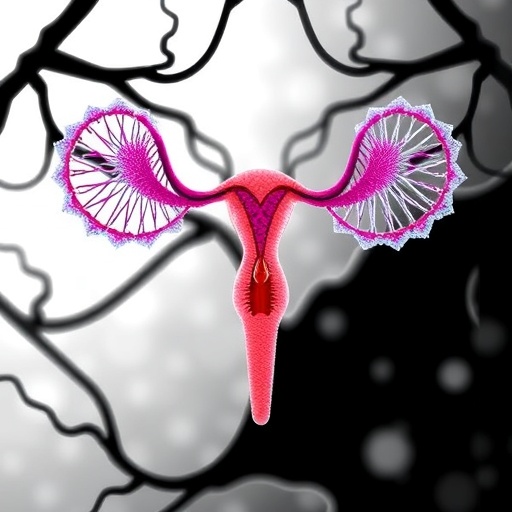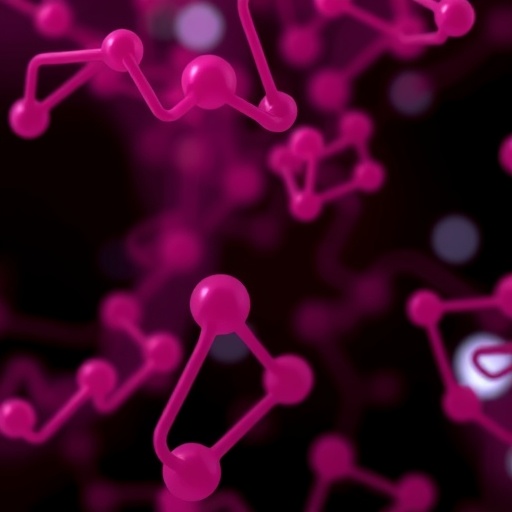
A groundbreaking study led by researchers at Peking University Third Hospital has illuminated the complex genetic landscape of ovarian cancer in Chinese patients, focusing on the rare phenomenon of double heterozygosity (DH) in cancer-predisposed genes. This newly published research, appearing in the 2025 volume of the esteemed journal BMC Cancer, delves into the intricate clinicopathological and hereditary features among patients who simultaneously harbor pathogenic variants in two different cancer-related genes. The discovery not only deepens the scientific understanding of ovarian cancer genetics but also has the potential to reshape clinical management and genetic counseling practices worldwide.
Ovarian cancer remains one of the deadliest gynecological malignancies, often diagnosed at advanced stages due to its asymptomatic nature in early phases. The role of inherited mutations in cancer-predisposing genes, particularly in BRCA1 and BRCA2, has been extensively studied and linked to elevated risks of ovarian and breast cancer. However, double heterozygosity—wherein patients carry germline pathogenic variants in two different cancer-susceptibility genes—has been an underexplored domain, especially within the Chinese population. This study confronts that gap by systematically analyzing genetic and clinical data from a sizeable cohort of ovarian cancer patients.
Between 2018 and 2024, 75 ovarian cancer patients with confirmed BRCA1 germline pathogenic variants were identified from genetic counseling sessions at Peking University Third Hospital. Remarkably, among these patients, six unrelated individuals were discovered to carry additional germline pathogenic variants in other cancer-predisposed genes alongside BRCA1. These secondary mutations encompassed a spectrum of genes implicated in DNA repair and genomic stability processes, including MUTYH, RECQL4, RAD51C, BRCA2, RAD54L, and ATM. The coexistence of such mutations raises compelling questions about their collective influence on cancer pathogenesis and patient outcomes.
In evaluating the clinical profiles of patients bearing double heterozygosity compared to those with a single BRCA1 mutation, the study found no statistically significant difference in age at diagnosis. DH carriers presented a median diagnosis age of 56 years, against 51 years for single BRCA1 variant carriers. Equally, critical clinicopathological features such as tumor stage, histopathological subtype, tumor behavior, and survival rates showed no observable divergence between the two groups. These findings suggest that while double heterozygosity introduces greater genetic complexity, the phenotypic expression of cancer in these patients largely mirrors that driven by BRCA1 mutations alone.
Notably, pedigree analysis revealed a distinct hereditary pattern among DH patients. All six individuals exhibited family histories encompassing multiple cancer types beyond ovarian malignancies. Although the frequency of ovarian cancer history within families was higher in the DH group (66.7%) compared to single BRCA1 carriers (27.5%), this difference did not reach statistical significance. More strikingly, DH carriers showed a significantly increased prevalence of family history involving non-ovarian and breast cancers (100% vs. 46.4%), underscoring the broader implications of harboring multiple germline mutations on familial cancer risk profiles.
The molecular mechanisms underpinning the compounded effects of these concurrent germline variants are complex. BRCA1 and BRCA2 play well-established roles in homologous recombination-mediated DNA repair, and mutations in these genes compromise genomic integrity, fostering tumorigenesis. Meanwhile, genes such as RAD51C, RAD54L, and ATM are intricately involved in DNA damage recognition and repair pathways. Mutations in MUTYH and RECQL4, crucial for oxidative DNA damage repair and DNA helicase functions respectively, may exacerbate genomic instability. The convergence of defects across these pathways in DH carriers could theoretically escalate oncogenic potential, albeit this study’s clinical data propose phenotypic dominance by BRCA1-related mechanisms.
This research carries pivotal clinical implications. Current management guidelines for BRCA1-mutated ovarian cancer patients encompass risk-reducing surgery, tailored chemotherapy regimens, and the deployment of targeted therapies like PARP inhibitors. The apparent phenotypic predominance of BRCA1 in DH patients implies that these existing protocols remain appropriate for managing such genetically complex cases. However, the expanded familial cancer spectrum linked to DH necessitates refined genetic counseling to alert family members about diversified cancer risks, prompting vigilant surveillance and possibly earlier interventions.
Furthermore, the study’s insights press for enhanced genetic testing strategies. Standard panels focusing on BRCA1/2 might overlook coexisting pathogenic variants that, while not overtly altering ovarian cancer presentation, influence familial cancer aggregation and treatment responsiveness. Broader gene panels encompassing a wider array of DNA repair and oncogenic genes could unveil hidden layers of hereditary cancer susceptibility, ultimately guiding precision oncology.
The rarity of DH in hereditary ovarian cancer underscores the challenge in assembling robust datasets for conclusive analysis. Nevertheless, the meticulous approach applied in this research—from genetic screening to comprehensive clinical and pedigree assessments—sets a benchmark for future studies investigating polygenic contributions to cancer. Larger multicenter collaborations and longitudinal follow-ups are essential to unravel subtle phenotypic nuances and potential therapeutic vulnerabilities in DH carriers.
Moreover, the psychological and ethical dimensions of detecting double heterozygosity warrant consideration. Patients confronted with multilayered genetic risks may experience heightened anxiety and require tailored support mechanisms to navigate complex decision-making processes about surveillance, prophylactic surgeries, and familial disclosure. Hence, oncology teams must integrate genetic counseling seamlessly with psychosocial care.
This study contributes profoundly to the narrative of personalized medicine in oncology by spotlighting the nuanced interactions between concurrent germline mutations and their clinical manifestations. While BRCA1 mutations remain a cardinal driver in ovarian carcinogenesis, the additive presence of other pathogenic variants paints a richer tapestry of inherited cancer predisposition, urging clinicians and researchers alike to recalibrate their frameworks for diagnosis, treatment, and familial risk assessment.
In conclusion, the pioneering findings from this Chinese cohort emphasize that the phenotypic landscape of ovarian cancer in DH patients is largely orchestrated by BRCA1-associated mechanisms. However, the broader oncogenic heritage evident in families signals an expanded horizon for cancer surveillance and prevention strategies. As genetic technologies evolve and our comprehension of hereditary cancer deepens, such studies pave the way toward more nuanced, genetically informed clinical paradigms that transcend singular gene perspectives.
This research not only enriches the scientific community’s understanding of ovarian cancer genetics but also heralds a new era where the interplay of multiple inherited mutations shapes patient care and family counseling. The clinical oncology field stands at the cusp of integrating multilocus genetic insights into everyday practice, promising enhanced outcomes and informed foresight for patients facing hereditary cancer risks.
Subject of Research: Clinicopathological and hereditary features of ovarian cancer patients with double heterozygosity in cancer-predisposed genes.
Article Title: Clinicopathological features of Chinese ovarian cancer patients with double heterozygosity for cancer-predisposed genes.
Article References:
Jin, Y., Wang, W., Wu, M. et al. Clinicopathological features of Chinese ovarian cancer patients with double heterozygosity for cancer-predisposed genes. BMC Cancer 25, 1391 (2025). https://doi.org/10.1186/s12885-025-14835-0
Image Credits: Scienmag.com
DOI: https://doi.org/10.1186/s12885-025-14835-0
Tags: advanced-stage ovarian cancer diagnosisBRCA1 and BRCA2 genescancer predisposition and heterozygosityChinese ovarian cancer researchChinese population cancer studiesclinicopathological features of ovarian cancerdouble gene mutation insightsgenetic counseling for cancer patientsgynecological malignancies researchhereditary ovarian cancer geneticsimplications for cancer management practicespathogenic variants in cancer genes




